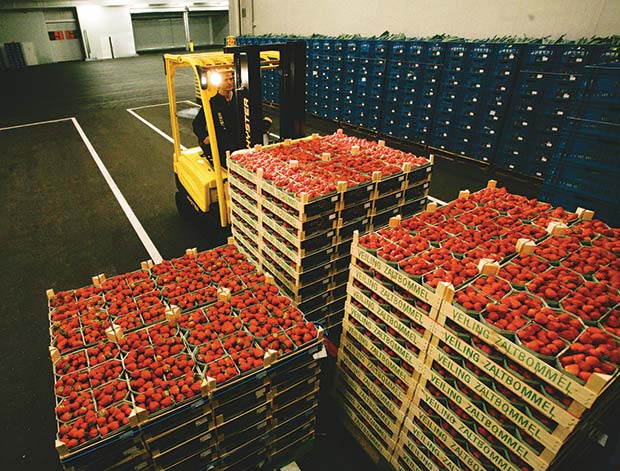To support productivity in the food and drink sector, RTITB is offering advice on how to improve the efficiency of forklift truck operations specifically in cold store environments.
 “With more energy consumed and battery life reduced by up to 35%, it can be difficult to keep trucks operating efficiently in the demanding cold store environment,” says Laura Nelson, Managing Director of RTITB, the preferred workplace transport training regulatory body. “Considering a few key things can help food and drink businesses increase productivity and reduce costs.”
“With more energy consumed and battery life reduced by up to 35%, it can be difficult to keep trucks operating efficiently in the demanding cold store environment,” says Laura Nelson, Managing Director of RTITB, the preferred workplace transport training regulatory body. “Considering a few key things can help food and drink businesses increase productivity and reduce costs.”
To help overcome the challenges of the cold store and achieve efficient supply chain operations, RTITB recommends employers take the following eight steps:
1. Select the right equipment
To reduce damage, breakdowns and accidents, businesses should first and foremost choose a forklift truck specifically designed for operating in cold stores.
Manufacturers use special components and features to help ensure both efficiency and safety. Special micro switches and motors for cold temperatures are included, the oil systems for the hydraulics can be filtered and trap moisture, and low viscosity hydraulic oils are used. In addition, exposed axles and joints can be treated for use in cold environments, machined surfaces are protected with anti-corrosion covering and non-slip floor, step and pedal areas may be provided.
2. Park outside the cold room
For protection and longevity, forklift trucks should be parked outside the cold store in an ambient temperature when not in use or on charge. However, to further prevent condensation build up on the truck, which can become ice on re-entry, employers should ensure trucks first pass through a low humidity, 0°C temperature zone when leaving a cold or sub-zero area.
3. Choose the maximum nominal capacity battery for the size of the truck
To compensate for the reduced capacity at low temperatures, businesses should select the maximum nominal capacity battery possible for the dimensions of their truck. This helps ensure optimal operation duration and offsets the shorter battery life which occurs under cold conditions.
4. Charge batteries correctly (and keep them charged)
Batteries should be charged at temperatures above 10°C, ideally at room temperature. This helps ensure the fastest possible charge time so that trucks are not left idle or underutilised. To help extend battery life, reducing unnecessary downtime and maintenance, before starting a shift, a full battery re-charge should be accomplished and batteries should either remain in operation or be on charge.
5. Conduct more regular maintenance
Trucks used in cold stores should have more frequent maintenance periods to ensure ongoing productivity. To identify and resolve any areas of concern before they become a serious problem, operators and engineers should regularly check braking system performance, condition of the tyres, wheels, forks, steering, battery and lubrication. Consideration should also be given to increased frequency LOLER* inspections due to the machine operating in arduous conditions. A competent person should decide on the scope and frequency.
6. Ensure pre-use checks take place
To tackle issues caused by moisture, or other factors, affecting the electrical components of the truck, pre-use inspections are essential. Forklift truck drivers must receive training on this crucial aspect of daily operation in order to reduce truck damage and downtime in the cold store.
7. Deliver the right level of training
As well as meeting legal requirements for adequate training, ‘Specific Job Training’ ensures that forklift operators are prepared for the challenging conditions they are likely to encounter at work in a cold store, as this adds significant complexity compared to the foundation skills learned during ‘Basic Operator Training’. It also provides drivers with more advanced knowledge of the specific type of truck they will be using.
Operators should also undergo closely supervised ‘Familiarisation Training’ on site in the ‘live’ cold store work environment. This allows the operator to put the knowledge they have learned into context while becoming familiar with the work area, ensuring they can conduct tasks efficiently, as well as safely.
RTITB can work with businesses to develop cost-effective cold store Specific and Familiarisation Training guidance. This ensures that both of these key areas of training are delivered effectively and add genuine business benefits, rather than further cost and time.
8. Provide operator comfort
Comfortable operators provide better performance in a demanding cold store operation. An operator should not spend too long in a cold environment and regular breaks will help drivers re-focus and increase efficiency and levels of safe operation.
Where a forklift truck has no enclosed cab, suitable clothing and headwear must be provided to ensure comfort isn’t compromised. However, selecting a forklift truck with an enclosed cab, which may include a heater, is often a better choice for operations where drivers are required to work a full shift in the cold store. As winter-style operator clothing may be restrictive and make it more difficult to move around, employers should also consider a cab with good visibility, perhaps even with the support of video cameras. Controls that can be used accurately while wearing gloves are also important.
To find out more about the support RTITB can offer to the food and drink sector, including training for cold store forklift truck operation, visit www.rtitb.co.uk or call Jane Hughes on +44(0)1952520207.
*LOLER – Lifting Operations and Lifting Equipment Regulations 1998
RTITB
Jane Hughes
Tel: 01952 520 207




Comments are closed.